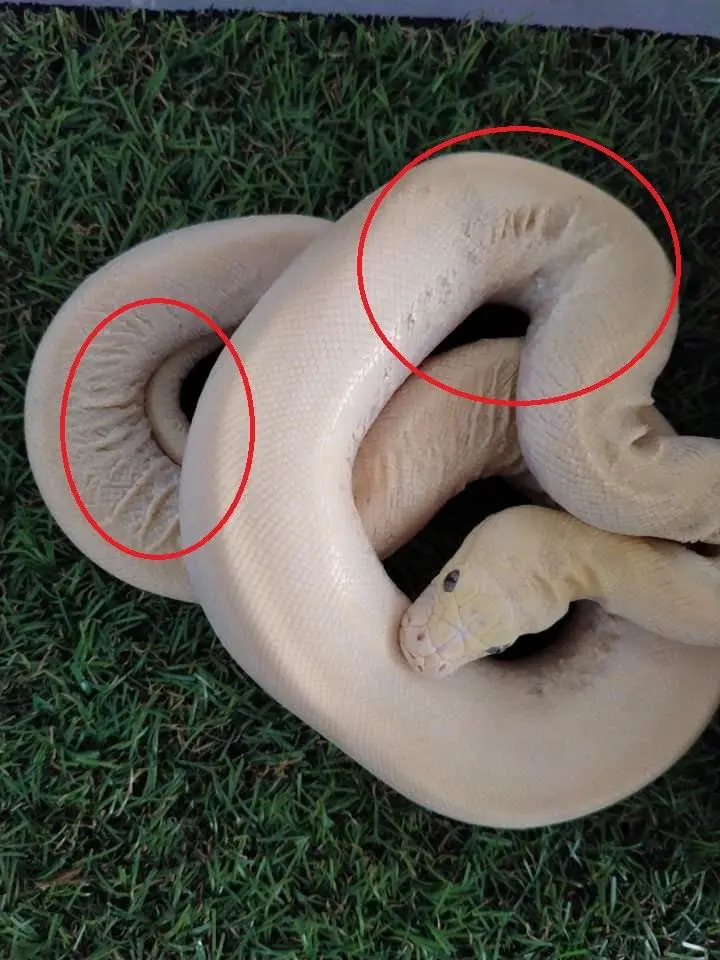Dehydration can be very dangerous for your pet ball python. If left untreated, it can lead to health problems, including lethargy, stuck sheds, and weight loss.
If ignored even longer, it can result in death. Pythons need to drink more after eating, as they lost a lot of water during digestion.
Dehydrated Ball Python Symptoms
There are a number of signs and symptoms you can look for to identify if your python is dehydrated. These include:
- Lack of appetite
- Skin folds or wrinkles, which can be seen along the sides or around the neck
- Dry tongue and inner mouth
- Cracked or dented eye caps
- Rapid weight loss
- Constipation
- Stuck shed around eyes, tail, and nose

Risks of Dehydration
If you ignore dehydration in your pet, it can result in death. Every living creature requires water. It’s important to ensure your snake has access to clean water at all times. Dehydration can result in further health issues, including:
- Shock
- Heart failure
- Acidosis
- Kidney failure
- Problems shedding
- Problems passing waste
- Problems with food digestion
Causes
Dehydration is a direct result of your ball python not drinking enough, though it is a little more complex than that.
Basically, in the wild, your pet would be in a humid environment, where it doesn’t need to drink much. They get the majority of their moisture through the skin and when eating prey.
When your ball python is in a drier environment and food is too dry, it can quickly become dehydrated.
Dehydration is also very common in shy pets. They need their water placed somewhere hidden. Ball pythons that are shy can become very sick due to dehydration. They would rather dehydrate than come out to drink in an open place.
Dehydrated Ball Python Treatment
The good news is that if you quickly identify your ball python is dehydrated, you can easily treat mild dehydration without the vet’s input. When the dehydration is further than what would be considered mild, then seek urgent veterinary care.
Soak
Pythons will often drink some water while soaking, but they can also absorb moisture through their skin.
Mild dehydration can easily be treated with a good soaking. You can use soaking for other conditions include stuck sheds, mites, and impaction.
Using a tub with a lock lid, make some holes in the lid. Fill the tub with enough water so your snake is covered at the thickest point. Heat the water to a maximum of 85ºF and allow your snake to soak for up to fifteen minutes.
Leave the snake to soak for 10-15 minutes.
Veterinary Treatment
If your ball python’s dehydration is not mild and soaking doesn’t work or your snake is showing any other signs of illness, then you will want to visit your reptilian vet.
There are a number of treatment methods your vet may choose depending on how severe the dehydration is.
They may place your pet in a humidity chamber or provide fluids intravenously. Some vets use electrolyte baths that are used to regulate fluids. In some instances, the vet may use a number of different treatments from fluid therapy to intravenous fluids.
Dehydration Prevention
The best way to reduce the risk of your ball python becoming dehydrated is to put preventative measures in place.
Humidity
Using a digital hygrometer, you can regularly and easily monitor humidity levels to ensure they remain within the safe limits for your pet. Ball pythons require humidity levels ranging from 50% to 65%.
Misting
Using a spray bottle on fine mist with fresh and clean water enables you to mist the enclosure up to twice a day. Misting increases humidity levels, but is also great for snakes that don’t enjoy drinking from a water bowl.
Misting enables your pet to drink from small pools of water on leaves and other decorations inside the enclosure. To save you time and energy, you can invest in a humidifier designed specifically for reptiles.
Substrate
Using the right substrate can reduce the risk of dehydration. Coco husk and sphagnum moss are excellent substrate choices for your ball python. Both retain moisture, helping to keep humidity levels up.
Water Dish
Always provide your snake with clean and fresh drinking water. The bowl should be cleaned daily. Pythons do have a bad habit of defecating or even knocking their water bowls over, so keep an eye on it.
Placing the bowl on the warm side of the enclosure will cause the water to evaporate faster than if it were placed on the cool side. Remember shallow dishes tend to evaporate faster as well.
Summary
Being able to quickly identify the signs of dehydration in your pet can help you provide fast and effective treatment, ensuring your pet remains happy and healthy.
Maintaining humidity levels within the enclosure, along with plenty of fresh drinking water can help to reduce the risk of dehydration moving forward.